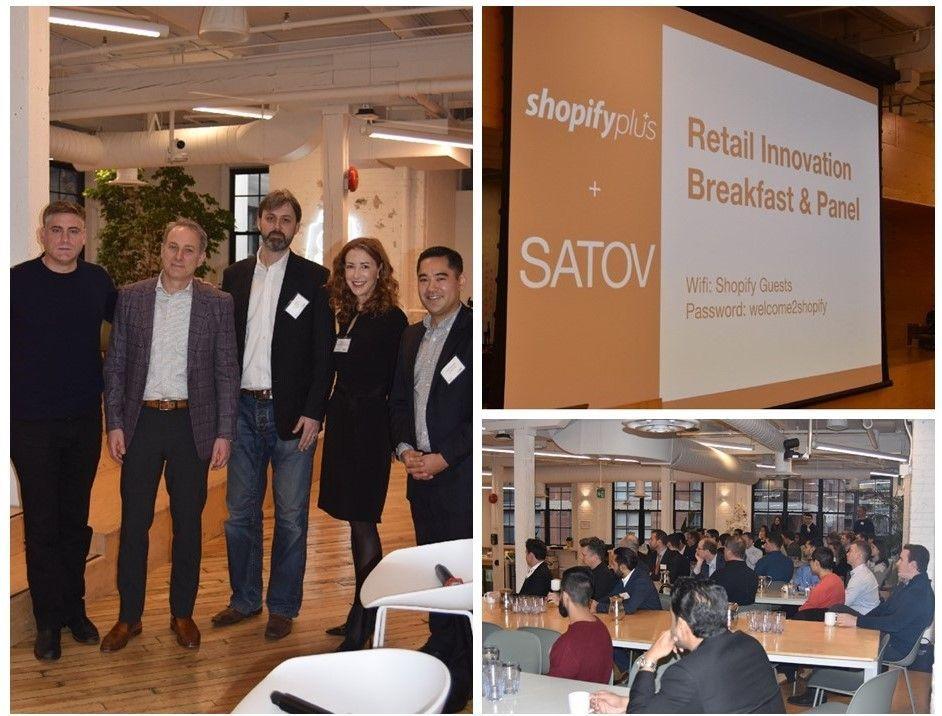
Blog post by Mark Satov
The apocalypse! The media world is filled with journalists and other experts claiming that the retail sector is on its deathbed, linking every high-profile bankruptcy to the explosion of the internet and the inability of legacy retailers to compete with Amazon. A subset of those experts attribute the blame to the Private Equity world, citing bankruptcies that were created (or accelerated) due to excess leverage and financial engineering.
In the run-up to the 2018 Christmas shopping season, SATOV Consultants and Shopify Plus brought together a panel of retail experts to discuss the state of retail today and the role of Private Equity in the successes and failures that we see. I moderated a panel comprised of Thecla Sweeney of Birch Hill Equity Partners, David Wyllie of LFL Group (owner of The Brick and Leon’s), Darren Matsunaga of Canadian Tire Corp. and Jordan Knapp of Shopify Plus. I did my best to remain objective and let the panel tell the audience where they stood.
We started with a few facts and figures to set the stage for the discussion including the fact that the internet has taken roughly 10% of the volume from brick and mortar stores over the last decade. In the United States, where retail square footage has grown by 30% since the mid-1990s, it is not hard to see why some malls and large retailers just have too much space on their hands. For the industry as a whole, adding 30% capacity while removing 10% of volume is going to hurt. However, in an industry with so many categories, so many players in so many regions, it can’t hurt everyone in the same way and to the same degree.
We asked the panel to help us understand why some retailers are surviving, even thriving, while others have emulated Sears and the like.
The panelists acknowledged that so many of the retailers were struggling because they were failing with the fundamentals, which was more of the reason for their demise than anything else. They also talked about their firm’s investment in the fundamentals and the in-store experience. Birch Hill acquired Mastermind on the basis of their amazing net promoter score and are focused on ensuring that it remains high as they build out the store network. Darren spoke of Canadian Tire’s strong dealer network and the ownership mentality that translates into results.
But what about the internet? You can’t ignore that and be successful! Of course not. Amazon and others are nowhere near finished adding categories and gaining share. The panel stressed that a growing portion of consumers prefer to complete their transactions online and that retailers need to be ready to serve those customers when and how they like. They need to consistently provide an amazing in-store experience to make it worth the trip for those who are so inclined, while also integrating the online channel into their overall experience. But just like how they didn’t need to be as cheap as Walmart on every product when they were taking over the world, they now don’t need to be as cheap as Amazon to survive the online revolution.
The panel talked about in-store technology. Although they are all thinking about it, the panelists have generally adopted a wait-and-see approach with much of the bleeding-edge technology that is hyped out there. In other words, they are way more focused on training their staff to consistently deliver an amazing experience than designing the next best in-store robot to replace them.
And finally, how should we think about Private Equity and its role in the retail landscape? According to Thecla of Birch Hill, retail can be a great place to invest as long as you pick a great player in the right category and support them with a team that knows how to operate. She was careful to note that while specialty products are more likely to be sold in-store than commodity items, even the most niche retailers need to be somewhere down the path of adapting an omnichannel strategy to be sustainable.
To inject my own spin, I have long argued that while retail is changing, it is more likely in the throes of a renaissance than an apocalypse. New models, new categories and new players are popping up all the time and there is room for many to win. You can always find a lazy reporter in search of a headline or an ‘expert’ who wants to be provocative to get their tweets read. They will tell you that Amazon will win everything, they are to blame for Sears’ demise, and that nary a shopping mall will exist by 2030. Nonetheless, the fact remains that people will be buying ‘stuff’ from now until the end of time, and that many people at many times will want to buy that ‘stuff’ in a box where they can talk to a human. Legacy retailers have albatrosses aplenty: too many stores that are too big, with a team that is not current and systems that don’t produce the right data. But, with the right team and the right owners – PE players included – traditional retailers can invest to thrive in the everchanging retail landscape.
Thanks again to Shopify Plus for co-hosting this event with SATOV and to our amazing panelists for their insights.
